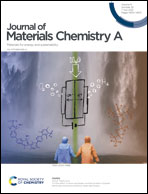A data-driven and DFT assisted theoretic guide for membrane design in flow batteries†
Abstract
Solvent treatment has been proved to be an effective strategy for the preparation of highly selective porous membranes for flow batteries. Herein, a fast and efficient method to screen suitable solvents to produce high performance porous polybenzimidazole (PBI) membranes was developed by a machine learning (ML) approach for the first time. The polymer–solvent interaction, which affects the final membrane morphologies, was further confirmed by Density Functional Theory (DFT). The predicted performance [voltage efficiency (VE) and energy efficiency (EE)] for a PBI membrane in a vanadium flow battery (VFB) can achieve a mean absolute prediction error (MAPE) within 1%. Based on the coefficients of membrane performance prediction models, solvent properties such as the melting point, heat of evaporation, dipole moment and surface tension exert significant influence on the morphology of PBI membranes and further their cell performance in VFBs. It was proved that alcohols are the most suitable solvents for solvent treatment of porous PBI membranes, due to similar polarity and strong interaction between alcohols and the PBI segment, which was confirmed by DFT calculations. This work provides an efficient methodology to regulate membrane morphologies and presents a concept to reveal the inherent relationship hidden in data mapping.



 Please wait while we load your content...
Please wait while we load your content...